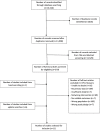Whole-system approaches to improving the health and wellbeing of healthcare workers: A systematic review
- PMID: 29200422
- PMCID: PMC5714334
- DOI: 10.1371/journal.pone.0188418
Whole-system approaches to improving the health and wellbeing of healthcare workers: A systematic review
Abstract
Background: Healthcare professionals throughout the developed world report higher levels of sickness absence, dissatisfaction, distress, and "burnout" at work than staff in other sectors. There is a growing call for the 'triple aim' of healthcare delivery (improving patient experience and outcomes and reducing costs; to include a fourth aim: improving healthcare staff experience of healthcare delivery. A systematic review commissioned by the United Kingdom's (UK) Department of Health reviewed a large number of international healthy workplace interventions and recommended five whole-system changes to improve healthcare staff health and wellbeing: identification and response to local need, engagement of staff at all levels, and the involvement, visible leadership from, and up-skilling of, management and board-level staff.
Objectives: This systematic review aims to identify whole-system healthy workplace interventions in healthcare settings that incorporate (combinations of) these recommendations and determine whether they improve staff health and wellbeing.
Methods: A comprehensive and systematic search of medical, education, exercise science, and social science databases was undertaken. Studies were included if they reported the results of interventions that included all healthcare staff within a healthcare setting (e.g. whole hospital; whole unit, e.g. ward) in collective activities to improve physical or mental health or promote healthy behaviours.
Results: Eleven studies were identified which incorporated at least one of the whole-system recommendations. Interventions that incorporated recommendations to address local need and engage the whole workforce fell in to four broad types: 1) pre-determined (one-size-fits-all) and no choice of activities (two studies); or 2) pre-determined and some choice of activities (one study); 3) A wide choice of a range of activities and some adaptation to local needs (five studies); or, 3) a participatory approach to creating programmes responsive and adaptive to local staff needs that have extensive choice of activities to participate in (three studies). Only five of the interventions included substantial involvement and engagement of leadership and efforts aimed at up-skilling the leadership of staff to support staff health and wellbeing. Incorporation of more of the recommendations did not appear to be related to effectiveness. The heterogeneity of study designs, populations and outcomes excluded a meta-analysis. All studies were deemed by their authors to be at least partly effective. Two studies reported statistically significant improvement in objectively measured physical health (BMI) and eight in subjective mental health. Six studies reported statistically significant positive changes in subjectively assessed health behaviours.
Conclusions: This systematic review identified 11 studies which incorporate at least one of the Boorman recommendations and provides evidence that whole-system healthy workplace interventions can improve health and wellbeing and promote healthier behaviours in healthcare staff.
Conflict of interest statement
References
-
- Lee DJ, Fleming LE, LeBlanc WG, Arheart KL, Ferraro KF, Pitt-Catsouphes M, et al. Health Status and Risk Indicator Trends of the Aging US Healthcare Workforce. Journal of Occupational and Environmental Medicine. 2012;54(4):497 doi: 10.1097/JOM.0b013e318247a379 - DOI - PMC - PubMed
-
- Edwards D, Burnard P. A systematic review of stress and stress management interventions for mental health nurses. Journal of advanced nursing. 2003;42(2):169–200. - PubMed
-
- Raiger J. Applying a cultural lens to the concept of burnout. Journal of Transcultural Nursing. 2005;16(1):71–6. doi: 10.1177/1043659604270980 - DOI - PubMed
-
- AbuAlRub RF. Job stress, job performance, and social support among hospital nurses. Journal of nursing scholarship. 2004;36(1):73–8. - PubMed
-
- Cooper CL, Dewe PJ, O’Driscoll MP. Organizational stress: A review and critique of theory, research, and applications: Sage; 2001.
Publication types
MeSH terms
LinkOut - more resources
Full Text Sources
Other Literature Sources
Medical
Miscellaneous


